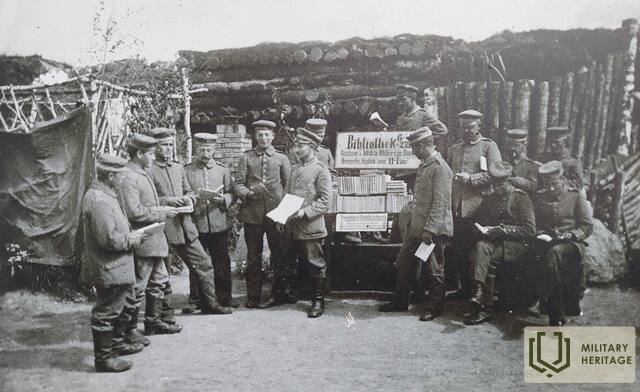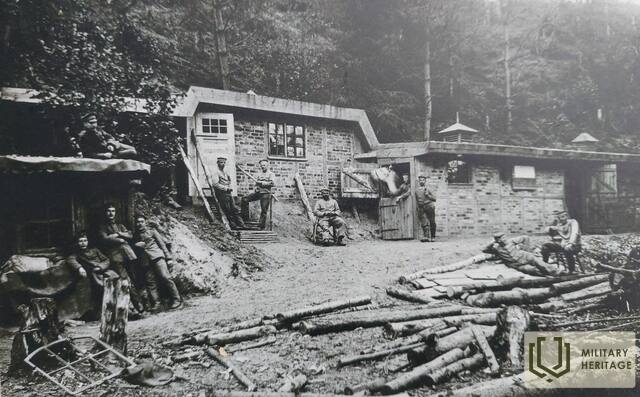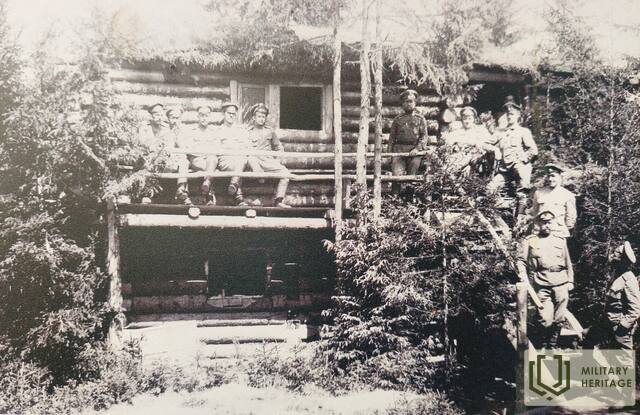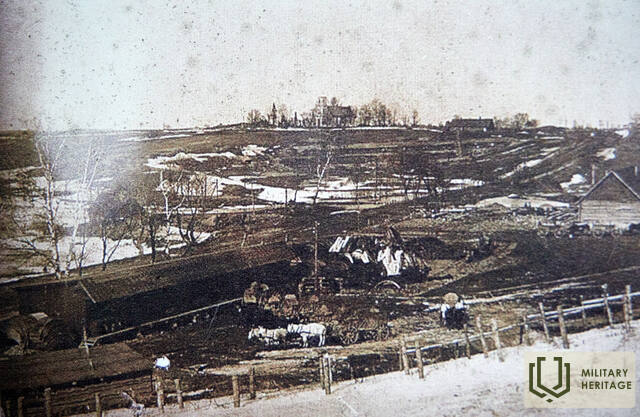About the underground city in Egypt and the Sodiškės
In 1915, when German troops entered the territory of Latvia, the first phase of the war was characterized by a war of maneuver. In the fall of 1915, when the front stabilized at the natural obstacle of the Daugava, a war of positions began, which lasted two years - until the fall of 1917, when the German army, taking advantage of the revolutionary changes in the Russian Empire and the demoralization and collapse of the Russian army, went on the offensive.
Any unit of troops that is not attacking begins to dig in and fortify itself. This is dictated by both military doctrine, tactical considerations, and the need to survive. Trenches and positions protect soldiers from direct and indirect fire (artillery) from the enemy, as well as from adverse weather conditions.
Initially, the positions were built from wooden logs, later – at the beginning of 1916 – concrete positions were built. In the German army, units were changed between sectors of the front less often, so the German soldiers approached the construction of positions more carefully – they knew that they were building the positions for themselves and that they would also have to live there. In the Russian army, units were moved between sectors regularly, and moreover, concrete positions were not built on the Russian side.
The first line of the Russian army passed through Medumi. The first line of the German defense was 400 meters further, on the other shore of Lake Medumi. Further south, in Sodiškės (nowadays, approximately the location of Upmaļi), there was the headquarters of the artillery regiment. There was an observation bunker near the headquarters. There was a whole row of bunkers in Sodiškės, but they were made of wood, so they have not survived. Only their locations are visible on the terrain.
In Egypt or Vilkumiesta, which was located on the German second line, an underground town was established. A post office operated in Vilkumiesta from 1836. Vilkumiesta was destroyed by the retreating Russian army in 1915 so that the Germans would have nowhere to live. Two more interesting historical facts are connected with Vilkumiesta – here from 1873 to 1874, Jānis Rainis studied at the Oskars Svensons boarding house. The school was founded by Baron Oettingen, who took care of the development of the parish. There is a story that his friend, the future German Chancellor Otto von Bismarck, visited Oettingen and spent 10 days in Vilkumiesta. Later, Oettingen also sent Bismarck strong drinks from the Kalkūni distillery he owned. Although such episodes are not described in Bismarck's biography, the story is quite plausible, considering Bismarck's close ties with the Baltic nobility and the fact that Bismarck was the Prussian ambassador to the Russian Empire from 1859 to 1862, working in St. Petersburg. The town of Vilkumiest was located on the St. Petersburg-Warsaw route, which was the fastest route to Germany.
The construction of the rear positions can be read about in the memoirs of pioneer lieutenant Hans Tröbst, who served in the 78th reserve pioneer company of the 147th infantry regiment of the 77th reserve division. This company was the only one in the entire division, so the infantry units themselves were also widely involved in the work, as well as the 42nd prisoner battalion, which quickly refused to work within the reach of the Russian army's artillery, based on international agreements. From the memoirs of H. Trobst: “The battalion commander decided to create a camp as a long, one-sided “street” on the selected slope. Since habitats must also have the ability to defend themselves, he also decides where the trenches will have to be dug. Each company received its own station and the work began! However, it is easy to say and listen to. But what difficulties it is to split the earth full of roots with these “tea shovels” - infantry sapper shovels. Roots and stumps were removed with bayonets, pocket knives, shovels and axes. From the far rear, carts with building materials were dragged like ants to each company. Every piece of wood turned out to be useful. The company was very lucky if it managed to find a birch grove. No matter how big such a forest was - it disappeared after 2-3 days. It was difficult to imagine a more suitable building material than birch. They were easy to transport, it was docile like a lamb - many things could be made from it and it also was done. Birch was used to make crosses for cemeteries, poles for dams, gratings for trenches, telephone poles, decorations for living spaces, bridge railings, chairs and beds. The ornaments worked like bees to prepare shelters for the next 6 months, or at least until spring.”
Whenever possible, soldiers, especially officers, lived in abandoned houses of local residents in the second lines and artillery positions. H. Trobst's memoirs describe the following living conditions: "The furniture was quite good - the farmer, the previous owner of the furniture, obviously lived quite well. The room had a large wall mirror, a sewing machine and European-style cabinets, chairs and tables. The walls were covered with wallpaper and decorated with paintings and dried flowers. The room was divided by walls up to the ceiling and proper doors were installed everywhere. In the center of the living room, between two doors, there was a large open fireplace, which I had constructed myself, it was adapted to burn with oak wood. The excellent oak wood, which was stacked at the back of the house, gave us excellent fuel."
Since there were not enough pioneers in the division and the infantry also performed construction work, First Lieutenant Trobst prepared methodological material for performing concreting work, "Concrete Guide (Anleitung zum Betonieren)", and each company received a description with drawings.
Since it was not possible to pour concrete bunkers on the front lines, it was decided to produce concrete slabs, or rather blocks, from which buildings could later be built. For this purpose, a concrete slab factory was established in Staro Dvorišče. The blocks had to be of such weight that one or two soldiers could lift them - 15 centimeters thick and 60×60 centimeters in size. Thin iron rods were placed inside them as reinforcement fasteners. Then the mold was filled with a mixture of cement and sand. The slabs came together so accurately that they could be used to pave streets. The pioneers were so proud of their product that they left a sign on each slab: “R. Pi.K. 78”, which translates as “Reserve Pionier-Kompanie 78”.
Related objects
Cycling route no. 790 "Through World War I bunkers"
A marked cross-border route that crosses the territory of Latvia and Lithuania.
During the First World War, the “Life and Death” front line was located on the territory of Latvia and Lithuania for several years. A complex system of fortifications with trenches, bunkers and bunkers was built on both sides of it. Thousands of soldiers fought and fell here in fierce battles, as evidenced by the countless burials of fallen soldiers.
The First World War has left long-lasting scars not only in the destinies and hearts of people, but also in our land. To this day, in the forests of Medumi parish, Augšdaugava region, there are still countless concrete bunkers, gun and ammunition depots, trenches, and graves of soldiers who fought on both sides of the front, built by the Germans.
This route offers the opportunity to see several better-preserved bunkers, as well as World War I exhibitions in Medumi and Turmata (Lithuania), dedicated to the First World War. The exhibitions invite visitors to view interesting artifacts, exhibits and testimonies of the First World War. The total length of the route in both countries is approximately 85 km.
On the bike route, there is an opportunity to scan a QR code at three German army bunkers and listen to a short audio story about the history and functional use of the bunkers. The audio stories are also available on the IziTravel platform HERE . The stories can be listened to in Latvian and English.
Important! Since this is a cross-border route and crosses the territory of both Latvia and Lithuania, we remind you that each person must have an identity document, passport or ID card with them.
First World War Museum
The fiercest battles of the First World War in Latvia took place near Daugavpils in August and October 1915, in the highlands of Ilūkste and Medumi. The Germans tried to break through to Daugavpils, but the Russians – to push them back. Both sides were unsuccessful and began to build trenches, creating in depth defence positions consisting of three lines.
The First World War Museum in Medumi is dedicated to these battles. The first part of the exhibition presents the history of the vicinity of Medumi, providing testimonies that bear evidence that Medumi was a well-populated and developed area before the war. Part 2 focuses on the events of the First World War in Europe and Latvia. Here, you can learn about the lives of soldiers and the innovations that emerged during the war, as well as examine the weapons used by the German and Russian armies. In the third hall of the exhibition, visitors can put themselves in the shoes of a soldier by experiencing bunker life. In this hall, a replica of a Russian bunker has been created – a fragment of a trench with a small shelter, elements of a battlefield and dummies of soldiers. Since the wooden bunkers of the Russian Army did not survive, they have been reconstructed at the museum, while the concrete bunkers of the German Army can be seen by visiting the International route of WWI Bunkers. The hall, with the imitation of a shelter, audio and video equipment, creates an authentic atmosphere of the battlefield.










